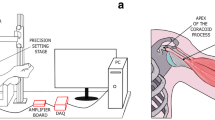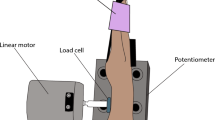Abstract
Objectives: The purpose of this research is to determine the impact of whole-hand vibration on the capacity of subjects to identify previously presented positions of the hand in both wrist flexion and extension. Methods: In each movement direction, targets of 15 or 30° were presented with an imposed passive movement from the start position. During the second imposed movement, subjects were required to identify when the target position had been reached. For the vibration condition, 15 s of whole-hand vibration exposure was repeated immediately prior to each target position trial. Proprioceptive capacity was assessed by comparing the identified angular position with the reference position–angular distance expressed in terms of absolute error (AE), constant error (CE), and variable error (VE). Results: For three of the four target positions (15 and 30° flexion and 15° extension), the absolute, constant, and VEs of target identification were insensitive to vibration, whereas for the 30° extension target, both the absolute and CE were significantly different before and after the vibration application, showing the subjects overshooting previously presented target position. All three error measures were larger for the long targets than the short targets. Conclusions: Short-duration exposure to whole-hand vibration is insufficient to compromise post-vibration position sense in the wrist joint, except near the end range of joint movement in wrist extension. Complement contribution of different proprioceptive receptors (muscle, joint, and skin receptors) seems to be crucial for accuracy to reproduce passive movements, since the capacity of any individual class of receptor to deliver information about movement and position of the limbs is limited.





Similar content being viewed by others
References
Aimonetti JM, Vedel JP, Schmied A, Pagni S (2001) Changes in the tonic activity of wrist extensor motor units induced by stimulating antagonist group I afferents in humans. Exp Brain Res 141:21–32
Aloisi AM, Carli G, Rossi A (1988) Response of hip joint afferent fibers to pressure and vibration in the cat. Neurosci Lett 90:130–134
Armstrong T, Bir C, Foulke J, Martin B, Finsen L, Sjogaard G (1999) Muscle responses to simulated torque reactions of hand-held power tools. Ergonomics 42:146–159
Brammer AJ, Taylor W, Lundborg G (1987) Sensorineural stages of the hand-arm vibration syndrome. Scand J Work Environ Health 13:279–283
Burgess PR, Clark FJ (1969) Characteristics of knee joint receptors in the cat. J Physiol 203:317–335
Burstrom L, Lundstrom R (1994) Absorption of vibration energy in the human hand and arm. Ergonomics 37:879–890
Capaday C, Cooke JD (1981) The effects of muscle vibration on the attainment of intended final position during voluntary human arm movements. Exp Brain Res 42:228–230
Capaday C, Cooke JD (1983) Vibration-induced changes in movement-related EMG activity in humans. Exp Brain Res 52:139–146
Collins DF, Prochazka A (1996) Movement illusions evoked by ensemble cutaneous input from the dorsum of the human hand. J Physiol 496:857–871
Corcos DM, Jaric S, Agarwal GC, Gottlieb GL (1993) Principles for learning single-joint movements I Enhanced performance by practice. Exp Brain Res 94:499–513
Craske B, Cranshaw M (1975) Shifts in kinesthesis through time and after active and passive movement. Percept Mot Skills 40:755–761
Cundiff JS (1976) Energy dissipation in human hand-arm exposed to random vibration. J Acoust Soc Am 59:212–216
Del Ray P, Lichter J (1971) Accuracy in horizontal arm positioning. Res Q 42:150–155
Edin BB (1992) Quantitative analysis of static strain sensitivity in human mechanoreceptors from hairy skin. J Neurophysiol 67:1105–1113
Eklund G (1972) Position sense and state of contraction; effects of vibration. J Neurol Neurosurg Psychiatry 35:606–611
Ferrell WR, Gandevia SC, McCloskey DI (1987) The role of joint receptors in human kinaesthesia when intramuscular receptors cannot contribute. J Physiol 386:63–71
Gauthier GM, Roll JP, Martin B, Harlay F (1981) Effects of whole-body vibrations on sensory motor system performance in man. Aviat Space Environ Med 52:473–479
Gilhodes JC, Gurfinkel VS, Roll JP (1992) Role of Ia muscle spindle afferents in post-contraction and post-vibration motor effect genesis. Neurosci Lett 135:247–251
Goodwin GM, McCloskey DI, Matthews PBC (1972) The contribution of muscle afferents to kinaesthesia shown by vibration induced illusions of movement and by the effects of paralysing joint afferents. Brain 95:705–748
Grigg P (1994) Peripheral neural mechanisms in proprioception. J Sport Rehabil 3:2–17
Grigg P, Finerman GA, Riley LH (1973) Joint-position sense after total hip replacement. J Bone Joint Surg Am 55:1016–1025
Hulliger M, Nordh E, Thelin AE, Vallbo AB (1979) The responses of afferent fibres from the glabrous skin of the hand during voluntary finger movements in man. J Physiol 291:233–249
Inglis JT, Frank JS (1990) The effect of agonist/antagonist muscle vibration on human position sense. Exp Brain Res 81:573–580
Inglis JT, Frank JS, Inglis B (1991) The effect of muscle vibration on human position sense during movements controlled by lengthening muscle contraction. Exp Brain Res 84:631–634
Jaric S, Corcos DM, Latash ML (1992) Effects of practice on final position reproduction. Exp Brain Res 91:129–134
Johansson RS, Landström U, Lundstrom R (1982) Responses of mechanoreceptive afferent units in the glabrous skin of the human hand to sinusoidal skin displacements. Brain Res 244:17–25
Lee WA, Kelso JAS (1979) Properties of slowly adapting joint receptors do not readily predict perception of limb position. J Hum Mov Stud 5:171–181
Lundstrom R, Johansson RS (1986) Acute impairment of the sensitivity of skin mechanoreceptive units caused by vibration exposure of the hand. Ergonomics 29:687–698
Martin BJ, Roll JP, Di Renzo N (1991) The interaction of hand vibration with oculomanual coordination in pursuit tracking. Aviat Space Environ Med 62:145–152
McCloskey DI, Macefield G, Gandevia SC, Burke D (1987) Sensing position and movements of the fingers. News Physiol Sci 2:226–230
Meyer DE, Abrams RA, Kornblum S, Wright CE, Smith JEK (1988) Optimality in human motor performance: ideal control of rapid aimed movements. Psychol Rev 95:340–370
Paillard J, Brouchon M (1968) Active and passive movements in the calibration of position sense. In: SJ Freedman (ed) The neuropsychology of spatially oriented behaviour. Dorsey, Homewood, IL, pp 37–55
Prablanc C, Echallier JF, Komilis E, Jeannerod M (1979) Optimal response of eye and hand motor systems in pointing at a visual target II Static and dynamic visual cues in the control of hand movements. Biol Cybern 35:183–187
Proske U, Morgan DL, Gregory JE (1993) Thixotropy in skeletal muscle and in muscle spindles: a review. Prog Neurobiol 41:705–721
Radovanovic S, Jaric S, Milanovic S, Vukcevic I, Ljubisavljevic M, Anastasijevic R (1998) The effects of prior antagonist muscle vibration on performance of rapid movements. J Electromyogr Kinesiol 8:139–145
Ribot-Ciscar E, Roll JP, Tardy-Gervet MF, Harlay F (1996) Alteration of human cutaneous afferent discharges as the result of long-lasting vibration. J Appl Physiol 80:1708–1715
Ribot-Ciscar E, Rossi-Durand C, Roll JP (1998) Muscle spindle activity following muscle tendon vibration in man. Neurosci Lett 258:147–150
Rogers DK, Bendrups AP, Lewis MM (1985) Disturbed proprioception following a period of muscle vibration in humans. Neurosci Lett 57:147–152
Roll JP, Vedel JP (1982) Kinaesthetic role of muscle afferents in man, studied by tendon vibration and microneurography. Exp Brain Res 47:177–190
Roll JP, Vedel JP, Ribot E (1989) Alteration of proprioceptive messages induced by tendon vibration in man: a microneurographic study. Exp Brain Res 76:213–222
Tax AAM, van der Gon JJD, Erkelens CJ (1990) Differences in coordination of elbow flexor muscles in force tasks and in movement tasks. Exp Brain Res 81:567–572
Wann JP, Ibrahim SF (1992) Does limb proprioception drift. Exp Brain Res 91:162–166
Wierzbicka MM, Gilhodes JC, Roll JP (1998) Vibration-induced postural posteffects. J Neurophysiol 79:143–150
Wise AK, Gregory JE, Proske U (1998) Detection of movements of the human forearm during and after co-contractions of muscles acting at the elbow joint. J Physiol 508:325–330
Acknowledgements
This work was supported by the Swedish Agency for Innovation Systems (VINNOVA). Special thanks are due to Dr. Uwe Windhorst for his valuable scientific comments and English language improvements of the text. We are most grateful to Lars Brundin for valuable technical assistance with mechanical and electrical engineering issues.
Author information
Authors and Affiliations
Corresponding author
Rights and permissions
About this article
Cite this article
Radovanovic, S., Day, S.J. & Johansson, H. The impact of whole-hand vibration exposure on the sense of angular position about the wrist joint. Int Arch Occup Environ Health 79, 153–160 (2006). https://doi.org/10.1007/s00420-005-0039-6
Received:
Accepted:
Published:
Issue Date:
DOI: https://doi.org/10.1007/s00420-005-0039-6




